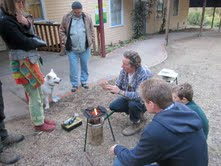What is Biochar?
“The Planet is our canvass”
Dolph Cooke dolph@biochar.org
Biochar is charcoal produced by heating organic material at a high temperature in limited oxygen. It is a stable product, very rich in carbon, which is used to lock carbon into the soil. Anyone can make charcoal — just burn some wood — but at high temperatures you get a more pure product with additional beneficial qualities. Of these positive properties, the one we are focusing on is its ability to rejuvenate the planet and its soil.1
Biochar has been described as:
…the single most important initiative for humanity’s environmental future … it allows us to address food security, the fuel crisis, and the climate problem, all in an immensely practical manner.
Prof Tim Flannery, Australian of the Year 2007.
What are the benefits of Biochar?
Incorporating biochar into the soil has been shown to bring about many beneficial and long-term positive effects on soil. It can:
- Increase the water holding capacity of the soil
- Increase crop production
- Increase soil carbon levels
- Increase soil pH
- Positively change the microbiology of the soil
- Decrease soil emissions of the greenhouse gases CO2, N2O and CH4
- Improve soil conditions for earthworm populations
- Improve fertiliser use efficiency
The effects of bochar will vary with soil type and the qualities of the biochar used. Studies so far have shown that the greatest positive effects of biochar applications have been in highly degraded, acidic or nutrient-depleted soils. In Australia, both the CSIRO and NSW Department of Primary Industry are conducting field trials on biochar.
How is Biochar made?
Biochar can be produced from any organic material such as household green waste, paper waste or agricultural waste. It is made in a specially constructed retort that heats the organic material in the absence of oxygen at temperatures above 430°C. The process, called pyrolysis, efficiently decomposes the biomass, producing the biochar solid, volatile gases and bio-oils. The gases and bio-oil can be used to generate heat or electricity or transport or fuel. The Biochar process is carbon negative when the biochar is incorporated into the soil. The figure below shows where biochar locates in relation to its key components. (NB: There are several views about these matters.)
How does Biochar help with climate change?
Burning trees and agricultural waste contributes a large amount of carbon dioxide (CO2) to the atmosphere, and is a significant factor in global warming. The production and use of Biochar breaks into the CO2 cycle, drawing carbon from the atmosphere to hold it in the soil.
Biochar – community
To counterbalance globalisation and our lack of control, influence and understanding of our local community, communities need to be empowered to act – say in relation to biochar with – for instance community biochar kilns. Learning Circles for instance seek to address this need by offering a way to understand and act that develops people’s capabilities in biochar in a sustainable manner. And, thereby help provides for ourselves and our children as well as assisting other communities do the same.
Biochar – policy
Biochar fits alongside other tools and instruments for sustainability, such as the Carbon Farming Initiative, Carbon Tax and particularly NGO initiatives such as a Biochar Trust and Carbon Sequestration NGO’s as well as State based Biochar policy in areas such as taxation, investment, regional development, public infrastructure such as transport and communication, and training. So Biochar is only ‘part’ of ‘the answer’ not the ‘whole’ answer. For urban communities hard hit by ‘downsizing’, or, rural and developing communities impacted by ‘free trade’, or intentional communities and networks of eco-villages seeking to design-in, rather than retro-fit existing communities, sustainable community economy, we believe that Biochar can make big difference, in particular for the people involved and their children.
Reference
Krull, E. (2010). Biochar for Agronomic Improvement and Greenhouse Gas Mitigation. CSIRO Sustainable Agriculture Flagship: 6pgs. Found on http://www.csiro.au/resources/Biochar-agronomic-improvement .
1 Picture taken from http://Biocharproject.org/. Used with permission.



Discuss - No Comments